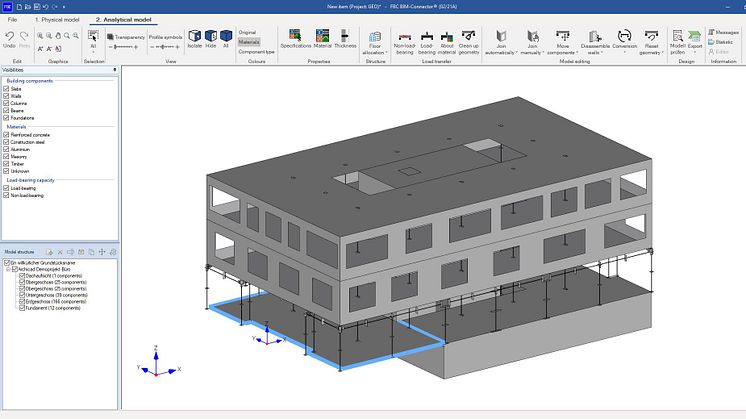
Press release -
FRILO optimises its BIM Connector® with the latest software update
Stuttgart, November 25, 2021 - Since 18 November, structural engineers have had access to the latest version of the FRILO software for structural analysis. Within this update, the provider of innovative solutions for structural analysis and structural design is launching a completely new solution for pile foundations in addition to numerous helpful functional enhancements in existing programmes. With the connection of the FRILO building model to the BIM Connector®, the company has also decisively advanced its commitment to integral building planning.
The new progamme Pfahl+ for pile foundation
With the new FRILO programme Pfahl+, the internal and external bearing capacity for reinforced concrete piles with rectangular and circular cross-sections can be verified. By linking the two proven FRILO programmes Soil Settlement SBR+ and Earth Pressure Calculation EDB+, both the ground settlements in the pile environment and the acting lateral pressure on the piles can be taken into consideration. By comparing the pile settlements and the soil settlements along the pile shell surface, an action from negative skin friction up to the neutral point can be optionally applied. The axial pile resistances due to skin friction and peak pressure can optionally be derived by evaluating static pile test loads or on the basis of empirical values according to the EA pile separately according to the two limit states SLS and ULS. The design of the reinforced concrete cross-sections is based on a non-linear calculation taking into account the additional loads according to theory II. The design of the reinforced concrete cross-sections is based on a non-linear calculation taking into account the additional loads according to second-order theory and the actual pile stiffnesses due to a freely selectable reinforcement.
FRILO BIM-Connector® convinces with improved practicability
In the course of Release 2022-1, the calculation model of the FRILO BIM Connector® was enriched with some practical editing functions. For example, the geometry of the model can be cleaned up by simply removing small recesses and openings as well as short beams, columns, walls and slabs that are not relevant for the structural analysis. In order to be able to ensure the correct transmission of loads, component axes can be pushed over each other. In addition, components can now be connected automatically by extending or shortening them in their system axis until they form an intersection line or point. The useful disassembly of walls into individual components is also possible since the software update. Those who want to check whether the building has been modelled in the correct axis after the clean-up can use the new function "Check model". This automated check can be applied not only to the complete building, but also to individual components in vertical and horizontal direction. The BIM Connector has gained additional appeal because FRILO has managed the direct connection of the FRILO building model. Cleaned models prepared for structural analysis can now be transferred loss-free and time-efficiently to the building model for the determination of the vertical and horizontal load transfer of the complete structure. Further transfer options to FRILO calculation programmes are then available for the actual component design.
Generation of wind and snow loads in the programme Framework RSX
In the course of the software update, the possibility was implemented in Framework RSX to automatically generate wind and snow loads for standard buildings that comply with the standard. In doing so, the programme automatically recognises the building contour of standard buildings. The panels (the areas between the bars) to which the generated load is applied for the selected wind direction are also created from the building contour and labelled appropriately without the user's intervention. The generation of the member loads from the area loads is carried out for the selected wind direction using the finite element method. The finite element method is then used to generate line loads on the load-bearing members from the area loads.
General innovations
The Document Designer FDD has been extended by the possibility of copying items within the programme using the convenient drag & drop function or to drag items from the FRILO Control Center directly into the FDD using the mouse. In the GEO building model, the view in X and Y direction as well as the load case-specific view of the moment curve are available as new display options for horizontal loads across all floors for the walls or columns that are recognised as being on top of each other. Furthermore, the determined H-loads on the individual wall columns and supports can be displayed in elevation. In addition, the stress curves of the wall columns standing on top of each other can be displayed. The programme HTB+ for the calculation of timber beams made of cross laminated timber now carries out the vibration verification. In the solution Reinforced Concrete Column B5+, high-strength steel in the steel grade SAS 670 from Annahütte is available as an additional option for the non-linear calculation (general method).
Topics
Categories
About the Nemetschek Group
The Nemetschek Group is a pioneer for digital transformation in the AEC/O industry. With its intelligent software solutions, it covers the entire lifecycle of building and infrastructure projects and guides its customers into the future of digitalization. As one of the leading corporate groups worldwide in this sector, the Nemetschek Group increases quality in the building process and improves the digital workflow of all those involved in the building process. Customers can design, build and manage buildings more efficiently, sustainably and resource-saving. The focus is on the use of open standards (OPEN BIM). The portfolio also includes digital solutions for visualization, 3D modeling, and animation. The innovative products of the 15 brands of the Nemetschek Group in the four customer-oriented segments are used by approximately six million users worldwide. Founded by Prof. Georg Nemetschek in 1963, the Nemetschek Group today employs more than 3,000 experts.
Publicly listed since 1999 and quoted on the MDAX and TecDAX, the company achieved revenue amounting to EUR 596.9 million and an EBITDA of EUR 172.3 million in 2020.




